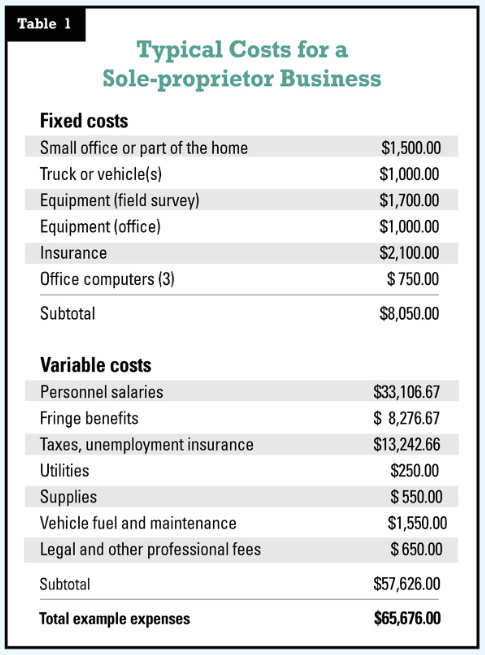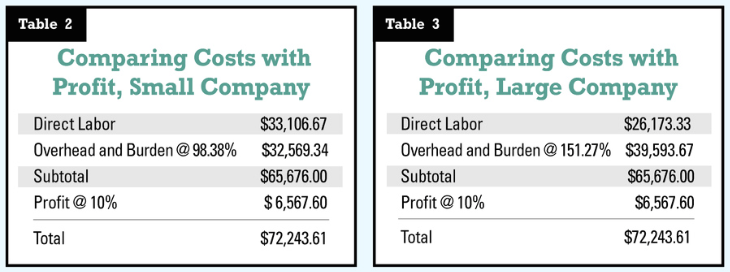The economics of land surveying
Editor’s note: This past May, Ambrose Gmeiner completed his Professional Science Masters Degree from the University of Maine. His final paper, The Land Surveyor as a Project Lead and Providing Professional Testimony, is the source for this series of articles on increasing the skills, strengths, and credentials of the professional land surveyor.
In this article, I review the basics of supply and demand economics as they relate to the business of land surveying, and I discuss the differences between providing surveying services on a fixed-fee basis versus a value-oriented basis. I also provide three examples of accounting summaries to demonstrate how much a company must earn to make a profit.
Supply and Demand
In order for a business to be successful, there must be demand for your product or service. This demand affects and is effected by supply.
Consider the case of land development as it pertains to the business of land surveying. When the market or economy is good, the demand for surveying increases, which reduces the number of businesses that can provide the developer with this service. This is a reduction in supply and an increase in demand.
This scenario drives up the price of surveying services because it’s being driven by a value-oriented business model. The land surveyor can request a higher fee based on the value of his or her services rather than just his hourly rate.
When the market declines or is in a recession, the number of businesses considering expansion or developing gets smaller, so land development declines. This causes an excess in the amount of firms available to do what work there is.
Thus the supply increases and the demand decreases, causing surveyors to reduce their fees in an attempt to win projects. Usually smaller businesses have to regroup and change their business model to survive, whereas larger firms may have more public sector work to sustain them.
What Is Your Fee Based On?
The scenario of too many survey firms leads to firms offering services at lower prices. Some businesses may even reduce their fees to cover only their operating costs. As the work diminishes, the fees diminish to an hourly rate based on how long a particular project takes to complete.
In this scenario, the surveyor writes the proposal, calculates the number of hours it takes the survey field crew, the drafter (drawing the plan), the technician (performing the calculations), and the land surveyor to review the plan and deem it complete.
Unfortunately, this method does not factor in the costs of the equipment or the fact that the project may take less field and office time due to efficient use of equipment and software.
Gone are the days of providing a price to complete a project solely on how much time the project will take to complete. Firms need to analyze the value of the surveying being performed and the market value of the project before they bid. In other words, how much will the economy allow for this service, and how much is the customer willing to spend? One unfortunate scenario (unless you’re the home buyer) is the cost of a title survey for a single-family home. In short, the title survey consists of the property boundaries and the existing improvements within the property and related to the property. At the completion of the purchase, the buyer gets to see the relative relationship of property corner markers and related features and how the property looks on a legal-sized plan with angles and distances and record information.
The problem occurs when this fee becomes fixed and does not change even as the surveyed property changes or the title and survey issues become more complex.
Under a value-based fee system, a surveying business would develop contacts and perform well, providing prompt responses and giving the customer a schedule. This surveying business would also keep the customer informed on any changes or updates. Eventually this quality work allows for the business to provide a service at a value-based price. The customer feels good about the service and the price, and the surveyor feels good about the outcome and fee received.
In a world of bid-type projects, the low bid typically wins regardless of the company’s expertise or people who work there. In a bid process, it’s assumed that all companies are qualified for the scope of work and therefore can bid on the project. We know this is not always the case, though.
Business Models
Recall the typical personnel in a small, sole-proprietor land surveying business. The business might consist of a professional land surveyor (proprietor), a survey technician, a draftsperson (a CAD draftsman now), and a secretary or office clerk. The survey field crew consists of a crew chief, an instrument operator, and if needed a rodman or helper. As a businessman, the land surveyor’s object is to make money. There are certain costs (fixed and variable) associated with the business, so the business needs to provide enough services to bring in money that is beyond the fixed and variable costs.
This example demonstrates fictitious business costs to show how much is needed to meet expenses and produce a profit of 10%.
Assuming payments are made for each item per month, let’s review some typical costs in today’s dollars (Table 1).
In this example, if the land surveying business were to make a simple 10% profit each month, the amount of services provided each month would need to be $65,676.00 plus $6,567.60 for a total of $72,243.61. The annual amount needed to produce a 10% profit would be $866,923.
In the real world, the business would face additional expenses such as equipment depreciation, equipment replacement, and contingencies. Many of the fixed and variable costs would fall under overhead and burden costs.
Another method to compare costs is using direct labor or salary costs with the overhead and burden applied and added, along with a desired profit margin. For example, we would take the personnel salary cost above and multiply it by an overhead and burden of 98.38%. Then we would sum those two numbers, multiply by a 10% profit, then add back to the direct labor, overhead, and burden as shown in Table 2. Although 98.38% was used, a typical overhead and burden rate is 150% to account for supplies, contingencies, and equipment replacements.
Another example could be the survey discipline leader of a much larger company. Suppose a small group includes a land surveyor, a one- or two-person field crew, and two office personnel. This would make a total staff of five people.
A realistic overhead and burden rate for this business may be closer to 151.27%. In order for that group to show a 10% profit, that group would need to cover salary costs, equipment and vehicle costs, as well as the company’s overhead and burden costs. Example division monthly costs are in Table 3.
In the end, for a business or division this size, there is not much reward for the proprietor or the discipline leader if he or she is only covering costs and not making a profit. Worst yet is if they are not covering costs and tapping into a credit line. It won’t be until surveyors change their business model to a value-based price that the outcome will be more rewarding.


